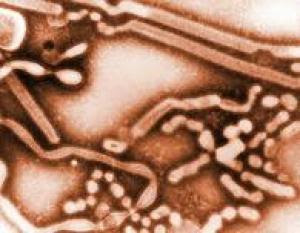
A new analysis of the current swine-origin H1N1 influenza A virus suggests that transmission to humans occurred several months before recognition of the existing outbreak.The work, published online in Nature June 10, highlights the need for systematic surveillance of influenza in swine, and provides evidence that new genetic elements in swine can result in the emergence of viruses with pandemic potential in humans.
'Using computational methods, developed over the last ten years at Oxford, we were able to reconstruct the origins and timescale of this new pandemic,' said Dr Oliver Pybus of Oxford University's Department of Zoology, an author of the paper. 'Our results show that this strain has been circulating among pigs, possibly among multiple continents, for many years prior to its transmission to humans.'
Dr Pybus, along with Andrew Rambaut from the University of Edinburgh and colleagues, used evolutionary analysis to estimate the timescale of the origins and the early development of the epidemic. They believe that it was derived from several viruses circulating in swine, and that the initial transmission to humans occurred several months before recognition of the outbreak.
The team conclude that 'despite widespread influenza surveillance in humans, the lack of systematic swine surveillance allowed for the undetected persistence and evolution of this potentially pandemic strain for many years.'
The team included researchers from Oxford, the University of Edinburgh, the University of Hong Kong and the University of Arizona.
Spiga
INTERNAL MEDICINE The internal medicine blog , where you can have details on alternatice medicine , latest trends in medicine , new drugs in the market , school of medicine etc
Swine Flu Origins Revealed
Saturday, June 13, 2009 at 7:30 AM Posted by Sajith
Subscribe to:
Comments (Atom)
Search
Labels
- Alzheimer's (10)
- Antibiotics (7)
- Anxiety (1)
- articles (2)
- Bacteria (1)
- behavioral abnormality (1)
- Bio technology (1)
- Brain (8)
- breast cancer (6)
- Cancer (40)
- cancer treatment (7)
- chemotherapy (6)
- Chlamydia (1)
- Cytology (3)
- Death (1)
- Diabetes Mellitus (7)
- Diet (17)
- DNA (1)
- Doctors (1)
- epilepsy (2)
- Fossil (1)
- fruits (1)
- genes (6)
- Genetics (13)
- Geriatrics (1)
- Health (12)
- Heart diseases (9)
- Herbal Medicine (2)
- HIV and AIDS (7)
- influenza (1)
- Inventions (1)
- IVF (1)
- latest findings (1)
- Life style (2)
- Lung Cancer (1)
- Lung Disease (9)
- Microbiology (1)
- Multiple Sclerosis (1)
- Nanotechnology (3)
- Neonatology (1)
- neurology (1)
- News (18)
- Parkinsonism (2)
- Prevention (1)
- Primates (1)
- Prostate cancer (1)
- Prosthetics (1)
- seizure (2)
- Skin (1)
- STD (2)
- Stem cells (9)
- Stroke (1)
- Surgery (2)
- Swine flu (11)
- Virus (1)
- weight loss (1)
Search The Web
Blogger Template by B-Themes | 2008
Minyx v2.0 template es un theme creado por Spiga. | Minyx Blogger Template distributed by eBlog Templates
